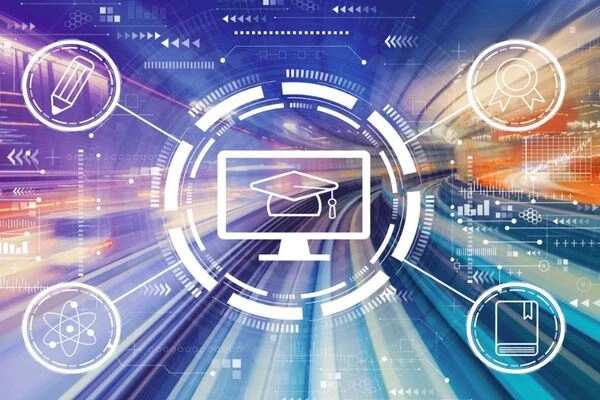IoT in education is becoming an essential trend, bringing a modern, interactive, and flexible learning environment. This technology not only helps students access knowledge in a more visual and engaging way but also supports teachers in managing classrooms efficiently and reducing manual tasks. At the same time, IoT enables administrators to monitor facilities, save energy, and enhance safety, while opening up opportunities for personalized and remote learning that meet the demands of the digital age.
What is IoT in Education?
IoT (Internet of Things) in education refers to the use of smart, Internet-connected devices to collect, exchange, and analyze data within the learning environment. These devices may include tablets, sensors, interactive smart boards, cameras, and environmental monitoring tools in classrooms. Connecting these devices not only helps teachers manage classrooms more effectively but also creates a personalized, intelligent, and convenient learning experience for students.

With the emergence of IoT in education, data on learning habits, teaching effectiveness, device usage, and school facilities is continuously collected, enabling schools and teachers to make accurate and timely decisions. As a result, IoT in education is no longer just a technology—it has become a strategic tool for improving the quality of teaching and learning.
Reasons to Apply IoT in Education
IoT is becoming an indispensable tool in the education sector because it brings practical benefits to students, teachers, and administrators alike. Specifically:

- Students learn in a more visual and engaging way: As “digital natives” who are used to receiving information quickly, students benefit from IoT through interactive and easy-to-understand digital learning tools.
- Teachers manage classrooms more efficiently: IoT reduces manual tasks such as taking attendance, tracking learning progress, and monitoring devices.
- Administrators optimize school facilities: They can track equipment, save energy, and ensure student safety.
- Flexible and personalized learning: IoT supports remote learning and allows students to learn at their own pace, aligning with global digital transformation trends.
Thanks to these benefits, many schools and educational institutions now consider IoT a key strategic component for improving teaching quality and enhancing the learning experience.
The Role and Benefits of IoT in Education
IoT in education brings clear advantages for students, teachers, and administrators, helping improve teaching quality while optimizing school management.
| Target Group | Key Benefits | Specific Details |
| Students | Interactive and visual learning environment | – Increased engagement and motivation
-Ability to track their own learning progress -Immediate feedback to improve performance |
| Teachers | More effective classroom management | -Control over classroom devices
-Monitor student participation -Assess learning outcomes using data collected from IoT devices -Adjust teaching methods in a timely manner |
| Administrators | Efficient monitoring and operational optimization | -Oversee school facilities
-Manage energy usage and reduce operational costs -Enhance safety and create a more modern learning environment |
In summary, IoT in education is not just a new technology but a strategic tool that enhances educational quality, improves learning experiences, and optimizes school operations.
Practical Applications of IoT in Education
The use of IoT in education has become increasingly diverse, ranging from classroom management and online learning to student tracking, assessment, and facility management. Below are some typical examples:

Classroom Management and Smart Devices
IoT helps teachers manage classrooms more intelligently by connecting devices such as tablets, interactive boards, surveillance cameras, and environmental sensors. With data collected from these devices, teachers can understand students’ level of focus, control the devices being used, and automate tasks like turning lights, air conditioning, or learning equipment on and off. This saves time and significantly improves classroom management efficiency.
Online Learning and Remote Interaction
With IoT, students can participate in online learning in a more interactive and engaging way. Smart, Internet-connected devices enable students to attend remote lessons, access learning materials, submit assignments, and interact directly with teachers. IoT also allows teachers to monitor each student’s participation, ensuring that everyone receives knowledge effectively.
More Effective Student Tracking and Assessment
IoT devices help collect detailed data about students’ learning activities—from study hours and assignment progress to test results. This data allows teachers to accurately assess each student’s abilities and progress. Moreover, data analysis helps identify students who are struggling, enabling timely support and the design of individualized learning paths.
School Facility Management
Beyond supporting teaching and learning, IoT in education helps optimize the management of school facilities. IoT sensors can monitor the status of equipment, electrical systems, water usage, temperature, and humidity in classrooms or laboratories. This information allows administrators to predict maintenance needs, optimize energy consumption, and ensure a safe, comfortable learning environment for students and teachers.
The Future Development of IoT in Education
The future of IoT in education promises significant transformations. When combined with technologies such as Artificial Intelligence (AI), Big Data, and Machine Learning, IoT will enable fully personalized learning systems. Students will be able to learn according to their own pace, abilities, and preferences, while teachers receive precise analytic data to optimize their teaching strategies.

In addition, IoT also enables the development of smart school models, where every activity—from learning and classroom management to facility operations—is connected and automated. This not only enhances the quality of education but also creates a flexible, modern, and sustainable learning environment.
Thus, investing in IoT in education is not merely a technological trend but a strategic step toward modernizing the education system to meet the needs of digital-native students.
IoT in education is more than just technology; it is a strategic solution that brings practical benefits to students, teachers, and administrators. With IoT, learning becomes more visual and engaging, classroom management is more efficient, facilities are monitored intelligently, and personalized learning becomes a reality. Implementing IoT is a crucial move to improve educational quality and build a safe, flexible, and modern learning environment.
